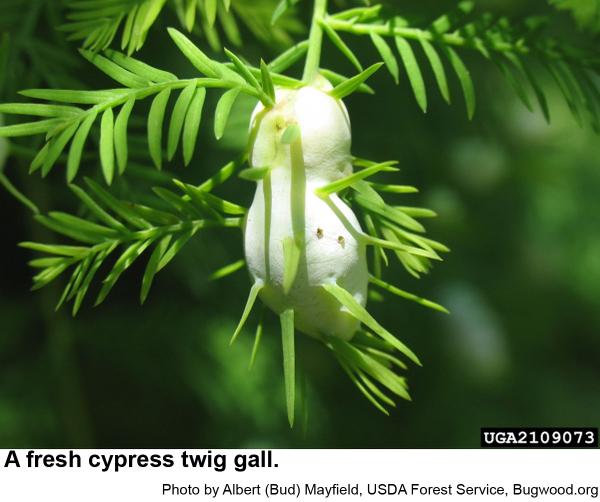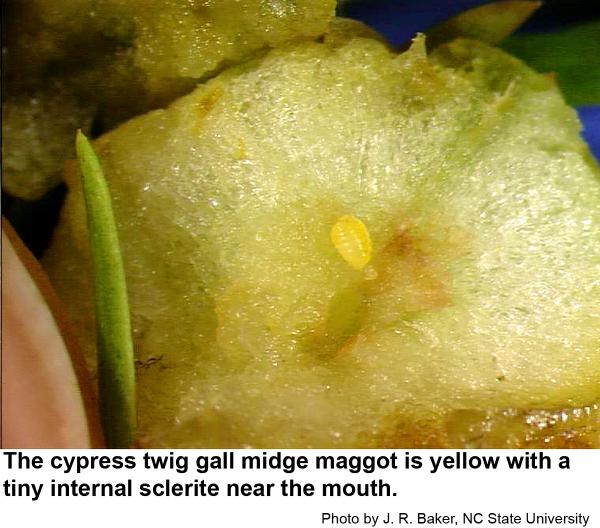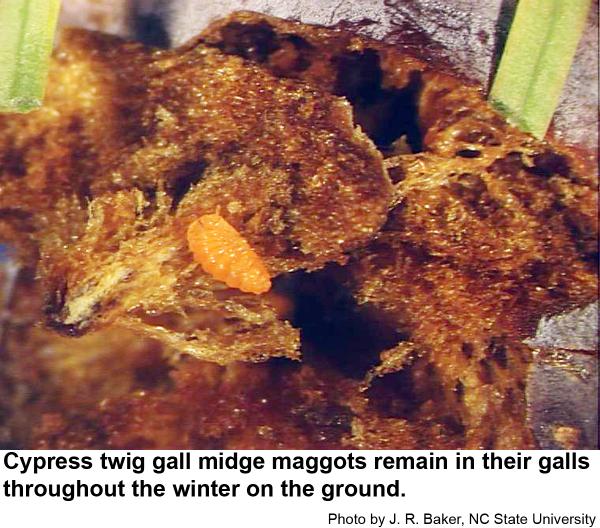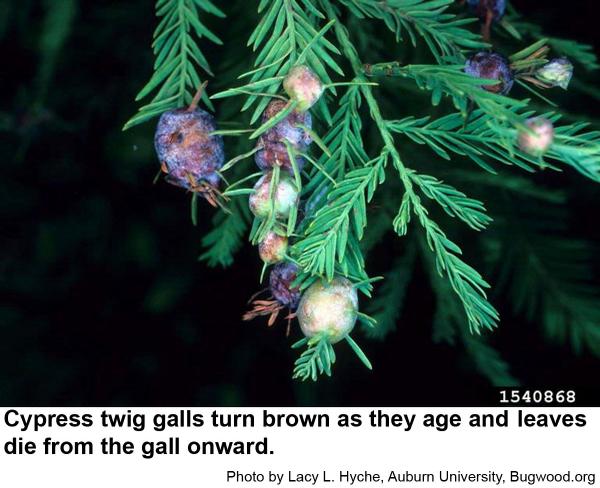Description and Biology
Cypress twig gall midges, Taxodiomyia cupressiananassa, are tiny gnat-like flies (less than 1/8 inch long - males are even smaller) that are tan with clear wings and red-orange abdomens (females) or tan-orange abdomens (males). They are called "twig gall" midges even though their galls are actually formed on the midribs of compound leaves. Females lay their eggs on young, succulent leaves. Eggs are bright orange, slender, and are laid in clusters of about 15. The developing maggots induce the midrib to swell up into a noticeable gall 3/4 to 11/4 inch long. New maggots are light orange, very small, and somewhat slender. An internal sclerite called the sternal spatula is visible right through the skin of older maggots. Mature maggots are fat, yellow to orange and then orange-red and are about 1/16 inch long when mature. New galls are pink or pale green with a white bloom. The galls are spongy and each gall can contain a dozen or more larvae (the bigger the gall, the more maggots are found inside). Galls turn brown with age, eventually dropping from the tree as leaves are shed. Maggots pupate inside the galls and adults may emerge from galls that are still on the tree later in the season. Maggots usually overwinter inside fallen galls to pupate and emerge as adults the following spring. We have one, possibly two, generations per year in North Carolina.
Host Plants
Cypress twig gall midges only infest bald cypress and pond cypress. The galls are unsightly as the leaf eventually dies beyond the gall. Mature brown galls are unslightly and may be so abundant that they cause branches to droop.
Residential Recommendations
Collecting and destroying fallen galls in autumn or in early spring before the midges become active and start laying eggs should help reduce the number of galls in the new season. Insecticide treatment is not recommended because the galls do not really harm the tree and there is no good, practical treatment for controlling them. At least four species of tiny parasitic wasps attack twig gall midge and help keep their populations in check. Outbreaks are sporadic, and a tree that was heavily infested with galls one year may have only a few galls in subsequent years.
Other Resources
- Common name: cypress twig gall midge, scientific name: Taxodiomyia cupressiananassa (Osten Sacken) (Insecta: Diptera: Cecidomyiidae). Gomez, C. and R. F. Mizell III. 2019 (reviewed). Featured Creatures. Entomology & Nematology, FDACS, DPI, EDIS Number: EENY-430.
- Cypress Twig Galls Adorn Baldcypress. Boggs, J. 2016. Bug Bytes.
- Cypress Twig Gall Midge, Vol. 4, No. 29. Layton, B. Jr. 2018. Mississippe State University Extension.
- Extension Plant Pathology Publications and Factsheets
- Horticultural Science Publications
- North Carolina Agricultural Chemicals Manual
For assistance with a specific problem, contact your local N.C. Cooperative Extension center.
This Factsheet has not been peer reviewed.
Publication date: April 2, 2019
Reviewed/Revised: Feb. 15, 2024
N.C. Cooperative Extension prohibits discrimination and harassment regardless of age, color, disability, family and marital status, gender identity, national origin, political beliefs, race, religion, sex (including pregnancy), sexual orientation and veteran status.




